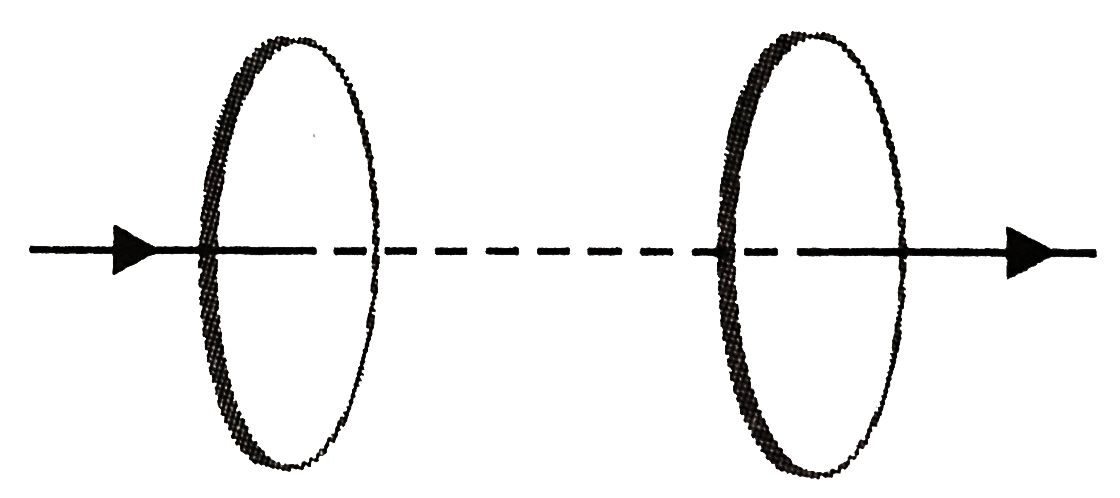The charging current for a capacitor is 0.25A. What is the displacement current across its plates?
The correct Answer is:0.05 A
To solve the problem of finding the displacement current across the plates of a capacitor when the charging current is given, follow these steps:
1. Understand the Concept of Displacement Current:
- Displacement current is a concept introduced by James Clerk Maxwell to account for the changing electric field in the region between the plates of a capacitor when it is charging or discharging. It is denoted as Id.
2. Identify the Given Information:
- The charging current Ic for the capacitor is given as 0.25A.
3. Relate Charging Current to Displacement Current:
- According to Maxwell's equations, the displacement current Id is equal to the charging current Ic when the capacitor is fully charged. This means:
Id=Ic
4. Substitute the Given Value:
- Since the charging current Ic is 0.25A, we can substitute this value into the equation:
Id=0.25A
5. Conclusion:
- Therefore, the displacement current across the plates of the capacitor is:
Id=0.25A
Final Answer:
The displacement current across the plates of the capacitor is 0.25A.
---
- Displacement current is a concept introduced by James Clerk Maxwell to account for the changing electric field in the region between the plates of a capacitor when it is charging or discharging. It is denoted as Id.
- The charging current Ic for the capacitor is given as 0.25A.
- According to Maxwell's equations, the displacement current Id is equal to the charging current Ic when the capacitor is fully charged. This means:
Id=Ic
- Since the charging current Ic is 0.25A, we can substitute this value into the equation:
Id=0.25A
- Therefore, the displacement current across the plates of the capacitor is:
Id=0.25A
The displacement current across the plates of the capacitor is 0.25A.
Similar Questions
The charging current for a capacitor is 1 A, then the displacement current is
View SolutionA parallel plate capacitor 20 μF is being charged by a voltage source whose potential is changing at the rate of 3 V/s. The conduction current through the connecting wires, and the displacement current through the plates of the capacitor, would be, respectively:
View Solution
Knowledge Check
Assertion : Displacement current goes through the gap between the plates of a capacitor when the charge of the capacitor does not charge
Reason : The displacement current arises in the region in which the electric field is constant with time.AIf both assertion and reason are true and reason is the correct explanation of assertionBIf both assertion and reason are true but reason is not the correct explanation of assertionCIf assertion is true but reason is falseDIf both assertion and reason are false
A parallel - plate capacitor is being charged.Show that the displacement current across an area in the region between the plates and parallel to it is equal to the conduction current in the connecting wires.
View SolutionA parallel - plate capacitor is being charged.Show that the displacement current across an area in the region between the plates and parallel to it is equal to the conduction current in the connecting wires.
View SolutionThe voltage between the plates of a parallel plate capacitor of capacitance 1μF is changing at the rate of 5 V/s. What is the displacement current in the capacitor?
View SolutionFig. shows a capacitor made of two circular plates each of radius 12 cm and separated by 5.0mm. The capacitor is being charged by an external source (not shown in the figure). The charging current is constant and equal to 0.15A.
(a) Calculate the capacitance and the rate of change of potential difference between the plates.
(b) Obtain the displacement current across the plates.
(c) Is Kirchhoff's first rule valid at each plate of the capacitor ? Explain.

View SolutionIf potential difference between the plates of capacitor changes with rate of dVdt=106voltsec, and capacitance of capacitors is 1μF, then find displacement current between the plates.
View SolutionA : The displacement current goes through the gap between the plates of a capacitor when the charge on the capacitor does not change.
R : Displacement current arises only when the electric field is constant.
View SolutionFigure shows a capacitor made of two circular plates each of radius 12cm, and separated by 5.0cm. the capacitor is being charged by an external source (not shown in the figure). The charging current is constant and equal to 0.15A
(a) Calcuate the capacitance and the rate of change of potential difference between the plates
(b) Obtain the displacement current across the plates
(c) Is kirchhoff's first rule(junction rule) vaild at each plate of the capacitor ? Explain.
 .
.
View Solution
